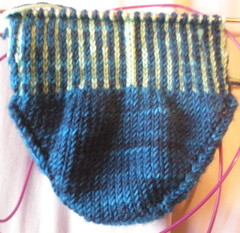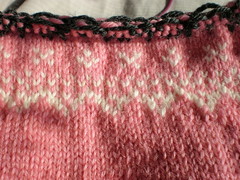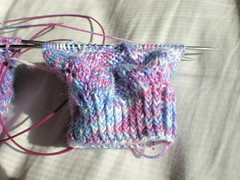Thursday, January 28, 2010
Wednesday, January 27, 2010
Dangerous Knitter Interview - Meet Iggystar!
What other crafty things do you do?
None at the moment, although I am considering dusting off some very ancient crocheting skills soon.
Why knitting?
I was lured into my LYS by the beautiful colored yarns in the window while wandering through an office building one day, where I met a lovely teacher who worked there. It was her encouragement, as well as that of a very good cyber-friend who's a knitter, that got me to sign up for classes. My friend even made me get on the Ravelry waitlist before I'd taken my first class!
Also, I really enjoy the comforts of my home after a busy work week and spend many weekends reading, watching television and gaming. So knitting is a good fit for how I spend my quiet, leisure time.
Have you ever injured yourself while knitting?
Nothing major outside of an occasional sore wrist due to not taking a break. However, I have wanted to harm few balls of yarn for not cooperating.
Tell us something unexpected you discovered while knitting.
First and foremost, I discovered that I CAN knit. I'm the least crafty person I know and I really thought I wouldn't be able to pick it up. Also, I didn't expect that knitting could be so addictive, engrossing, cool and fun (and at times expensive)!
Have you gotten any strange comments about your knitting or while knitting in public?
Absolutely! I'm surprised that so many people come up to me tell me how lovely my crocheting is (I guess they miss the extra needle). One constant (and a bit irritating) comment are those who say they don't have the time, or don't have the patience to knit. They make it sound like such a putdown. Sometimes I'll tell them that knitting teaches you patience.
What projects are you really proud of?
I'm really proud of all of my firsts. My first scarf, hat, non-classroom pattern, cable project, pair of socks, etc. The latest source of much pride is a my first charted lace project, The Liesel scarf.
What projects were total failures?
I don't really have any projects that I consider complete failures. There might be aspects of a project where I've made mistakes, like on my second pair of socks. I didn't calculate the guage correctly and they turned out huge. Big enough to fit both feet in one.
What do you consider challenging?
Gauge, reading my knitting and identifying mistakes. I despise gauge with a passion, plain and simple. I get so bored working those swatches...I want to get started already! The latter two are a part of knitting that I'm constantly working on. Losing the stitch count, trying to find the position of my last decrease, finding my error so I can fix it and continue, etc.
Best piece of knitting advice you've ever heard is...
On expressing my fear of more challenging projects a fellow Raveler replied, "You shouldn't be afraid of knitting. It's needles and yarn, nothing is going to blow up." It was frank, but it kind of put those more difficult knitting projects into perspective.
Go read Iggy's Blog!
Tuesday, January 26, 2010
Claire's wedding shawl
For all you who fear the lace and the charts.... the chart for this sucker was 4 pages, every row is basically different. Knit in silk that just wanted to slide off the needles. Embrace the fear and DO IT!
Monday, January 25, 2010
Awesome Socks - the beginning
One of my many creative fears is designing my own work. It's total nonsense. I'm scared that people will think my ideas are stupid so I never even start on awesome projects floating around in my head.
Hello Crazy Person in my head, its time for you to stop running my life!
That's what A Year of Knitting Dangerously is all about - Shutting up the crazy person in our heads and doing awesome things!
This is the beginning of my Awesome Socks. The sole is all stripey, because stripes on the bottom of your feets are AWESOME! I won't show the rest of the sock just yet. Gonna let the anticipation build!!
Hello Crazy Person in my head, its time for you to stop running my life!
That's what A Year of Knitting Dangerously is all about - Shutting up the crazy person in our heads and doing awesome things!
This is the beginning of my Awesome Socks. The sole is all stripey, because stripes on the bottom of your feets are AWESOME! I won't show the rest of the sock just yet. Gonna let the anticipation build!!
Saturday, January 16, 2010
Juliana's Car Sack
Here's why you should read the ENTIRE pattern first before deciding something is the cutest thing ever and you must cast on right this very second. I saw this pattern in the Dale of Norway book for Vancouver 2010 Olympics. Its a sweater for a baby that goes all the way down to the toes forming a sack with flaps that open so that you can feed the buckles of the carseat through it. A sack with sleeves essentially. Cute and awesome for my new niece! Problem is, I didn't read the pattern and there are... gasp... STEEKS! I'm going to have to cut this baby three times in order to finish it. Now that is knitting dangerously! I'm going to need some hand holding thru ths one. And perhaps a drink.
Friday, January 15, 2010
Possibility Socks
After casting on the Harry Clarke shawl and getting 95 freaking beads on the FIRST row, I needed to immediately cast on some easy-on-the-brain knitting. These are Cookie A's Monkey socks. Yeah I know, Knitting Wisdom would normal advise I go with a nice simple toe-up stockenette sock, but I just finished knitting 20 inches in stockenette and frankly I needed a little more for my brain to work on. The bonus with Cookie A's pattern is that its both charted and written so I'll be able to use this pattern for my "How to KNIT from a chart" tutorial that's coming this week. But here's the problem with these socks. The pattern is fairly simple and engaging which makes them hard NOT to knit. I got Harry to worry about! I can't forsake him just to knit socks! So I've decided these socks will be "train knitting" only. Socks are a good project just to throw in your bag and whip out when you find yourself with a few empty minutes. And why are they called "Possibility Socks"? I'm taking this workshop on leadership (hence all the train knitting time I'll have commuting into NYC for the class) and part of the class talks about community and how in community, nothing is impossible. So I thought I'd carry the idea of Possibility around with me, quite literally, in sock form!
Harry Clarke - cast on
This is my first project for A Year of Knitting Dangerously. I've never done bead work before and I must say, its a very fussy process. I'm not sure I'm going to like it. We'll see when we get into the actually knitting of the shawl. And man, this sucker is going to be heavy. All those beads! I'll have to take myself to the opera or something so that I can fully appreciate the dramatic effect of tossing this baby over my shoulder.
Tuesday, January 12, 2010
How to read a knitting chart
When I started the Year of Knitting Dangerously on Ravelry, one of the fears/challenges that immediately cropped up was knitting from a chart. This was a bit of a mystery to me. You just read the chart, knit the stitch and go. What’s so tough about that? Duh, this is just Knitting101, how could you not be able to knit from a chart? Then I cast on 2 projects with charts and realized that if charts were Knitting101, it’s the secret class that no one ever tells you about. Like the Mason’s secret handshake, charts are one aspect of knitting that is never explicitly taught or explained. Chart writers assume you know how to knit from a chart and assume you have a certain level of sill, proficiency and spatial understanding. Knitting fro a chart is exceptionally straight forward, if and only if you take the time to apply the information the chart is providing and is NOT providing.
When I started knitting I was fortunate enough to have a needle craft walking encyclopedia at my side. This woman wrote her thesis on the socio-economic implications of the Bayeux Tapestry for god sakes! And to this day, I’m not above whining “Mommy fix it!” as I toss my botched knitting into her skilled hands. Since not everyone has a Fix-it-Mommy for the knitting woes, herein lines my tutorial on how to read a knitting chart, soon to be followed by how to knit from a knitting chart.
Step 1 – Read the whole pattern.
Pour yourself a tasty beverage and read the entire pattern. The ENTIRE pattern. Don’t even tough your needles net. Some patterns will say something like "Cast on 100 Stitches. Follow chart. Cast off and weave in ends.” Other patterns will have you establish your knitting then use the chart for specified sections only. So you need to know what those specified sections are.
Things to look out for – Does the chart repeat? Does the whole chart repeat? How any times? Do small sections of the chart repeat? Is there knitting to be done (like ribbing, garter stitch boarders) before or after the chart section? Are there any special instructions? Go a head and highlight or underline important instructions in your patter. I don’t mind and I won’t tell if you write in your knitting book.
Step 2 – Familiarize your self with the Key.
All knitting charts will have a legend or key telling you what the marks and squiggles mean. And every chart writer and every pattern company uses a different system (there is some movement in the community to standardize this, but for now, you have to learn a new key with each pattern).
Things to look out for - How is a “knit stitch” represented? A “purl” stitch? Any funky stitches you need to know about like “K2tog” or “ktbl”? Is there an “M1” on the chart? Now check the pattern instruction, how exactly does the writer want you to “make 1 stitch”?
Tricky Tip: Pay particular attention to the symbol for the knit stitch. Since the knit stitch is the most common stitch, it may not have a designated symbol. It may just be represented by a blank square. If it has a symbol, take a quick look at the chart itself. Are there any blank square? If so, don’t panic. You will skip this square, performing no action as if it wasn’t there and go right on to the next stitch as if nothing happened because, well, nothing happened. If there is a decrease in a row without a corresponding increase in that same row, the chart will be short a stitch and the empty box serves as a place holder until the increase is executed.
Step 3 – Get to know the chart.
So now you know what every square is supposed to mean. Now you just have to put it all together. Is every row represented on the chart? Sometimes with lace knitting, only right side rows are represented in the chart. The instructions will tell you “WS, purl all stitches” So now you know all RS rows are on the chart and all WS rows are purled and are NOT on the chart. Is there a section of the chart that repeats? Lace stoles might have a boarder on both sides and a center pattern that is repeated. So now you know what’s a head of you and what stitches you will need to execute, where and how many times. You are almost ready to cast on!
When I started knitting I was fortunate enough to have a needle craft walking encyclopedia at my side. This woman wrote her thesis on the socio-economic implications of the Bayeux Tapestry for god sakes! And to this day, I’m not above whining “Mommy fix it!” as I toss my botched knitting into her skilled hands. Since not everyone has a Fix-it-Mommy for the knitting woes, herein lines my tutorial on how to read a knitting chart, soon to be followed by how to knit from a knitting chart.
Step 1 – Read the whole pattern.
Pour yourself a tasty beverage and read the entire pattern. The ENTIRE pattern. Don’t even tough your needles net. Some patterns will say something like "Cast on 100 Stitches. Follow chart. Cast off and weave in ends.” Other patterns will have you establish your knitting then use the chart for specified sections only. So you need to know what those specified sections are.
Things to look out for – Does the chart repeat? Does the whole chart repeat? How any times? Do small sections of the chart repeat? Is there knitting to be done (like ribbing, garter stitch boarders) before or after the chart section? Are there any special instructions? Go a head and highlight or underline important instructions in your patter. I don’t mind and I won’t tell if you write in your knitting book.
Step 2 – Familiarize your self with the Key.
All knitting charts will have a legend or key telling you what the marks and squiggles mean. And every chart writer and every pattern company uses a different system (there is some movement in the community to standardize this, but for now, you have to learn a new key with each pattern).
Things to look out for - How is a “knit stitch” represented? A “purl” stitch? Any funky stitches you need to know about like “K2tog” or “ktbl”? Is there an “M1” on the chart? Now check the pattern instruction, how exactly does the writer want you to “make 1 stitch”?
Tricky Tip: Pay particular attention to the symbol for the knit stitch. Since the knit stitch is the most common stitch, it may not have a designated symbol. It may just be represented by a blank square. If it has a symbol, take a quick look at the chart itself. Are there any blank square? If so, don’t panic. You will skip this square, performing no action as if it wasn’t there and go right on to the next stitch as if nothing happened because, well, nothing happened. If there is a decrease in a row without a corresponding increase in that same row, the chart will be short a stitch and the empty box serves as a place holder until the increase is executed.
Step 3 – Get to know the chart.
So now you know what every square is supposed to mean. Now you just have to put it all together. Is every row represented on the chart? Sometimes with lace knitting, only right side rows are represented in the chart. The instructions will tell you “WS, purl all stitches” So now you know all RS rows are on the chart and all WS rows are purled and are NOT on the chart. Is there a section of the chart that repeats? Lace stoles might have a boarder on both sides and a center pattern that is repeated. So now you know what’s a head of you and what stitches you will need to execute, where and how many times. You are almost ready to cast on!
Labels:
charts,
Knit Dangerously,
knitting,
knitting101,
Ravelry,
tutorial
Subscribe to:
Posts (Atom)









